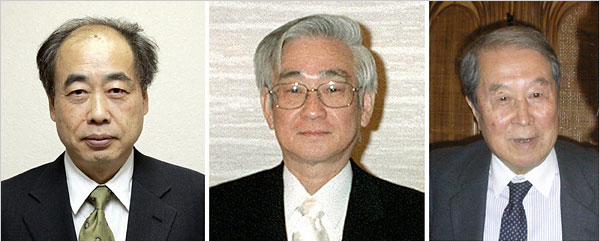Yoichiro Nambu, 87, of the University of Chicago’s Enrico Fermi Institute, will receive half of the 10 million krona prize (about $1.4 million) awarded by the Royal Swedish Academy of Sciences.
Makoto Kobayashi, 64, of the High Energy Accelerator Research Organization in Tsukuba, Japan, and Toshihide Maskawa, 68, of the Yukawa Institute for Theoretical Physics at Kyoto University, will each receive a quarter of the prize.
Ever since Galileo, physicists have been guided in their quest for the ultimate laws of nature by the search for symmetries, or properties of nature that appear the same under different circumstances. “It’s the lamppost we search under,” said Michael Turner, an astrophysicist at the University of Chicago.
One example of an obvious symmetry is a snowflake, which looks the same when you rotate it one-sixth of a turn. Another is Einstein’s theory of relativity, which says the laws of physics are the same no matter what speed. However, in the 1960s, Dr. Nambu, inspired by studies of superconductivity, suggested that some symmetries in the laws of elementary particle physics might be hidden, or “broken” in actual practice. “You have to look for symmetries even when you can’t see them,” Dr. Turner said.
The principle of symmetry breaking is now embedded in all of modern particle physics. The $8 billion Large Hadron Collider, a giant particle accelerator soon to go into operation outside Geneva, was designed largely to find a particle known as the Higgs boson, which is theorized to be responsible for breaking the symmetry between electromagnetism and the so-called weak nuclear force, imparting mass to many particles that in theory are massless.
Imagine a pencil balanced on its point on a table — one of physicists’ favorite examples. To the pencil while it is still on its point, all directions along the table are the same. But the standing pencil is unstable and will eventually fall onto the table pointing in only one direction.
Applying this notion to a puzzle in the subatomic realm, Dr. Nambu explained why a particle known as the pion, which carries the strong nuclear force that holds atomic nuclei together, was much lighter than the protons and neutrons inside it. If it were not so light, the strong force would not extend far enough to stick nuclei heavier than hydrogen together, said Daniel Friedan, a physicist at Rutgers.
The fact that the pion is light, he said, explains why there is a variety of atoms in the world. “There is a variety of atoms because there is a variety of nuclei,” Dr. Friedan wrote in an e-mail message.
In 1972, Dr. Kobayashi and Dr. Maskawa, extending work by the Italian physicist Nicola Cabibbo, showed that if there were three generations of the elementary particles called quarks, the constituents of protons and neutrons, the principle of symmetry breaking would explain a puzzling asymmetry known as CP violation.
At the time, only three kinds of quarks were known: the up and down quarks, which make up most ordinary matter, and the strange quark. In 1974, the so-called charmed quarks were discovered. The last pair, the bottom and top quarks, were discovered in 1977 and 1994, completing the three generations of two quarks each predicted by Dr. Kobayashi and Dr. Maskawa.
The CP violation — C and P stand for charge and parity, or “handedness” — was discovered in 1964 by the American physicists James W. Cronin and Val L. Fitch — a discovery that also won a Nobel Prize. Until then, physicists had assumed that exchanging positive for negative and left-handed for right-handed in the equations of elementary particles would result in the same answer.
The fact that nature
operates otherwise, physicists hope, is
a step toward explaining why the
universe is made of matter and not
antimatter, one of the questions that
the Large
Hadron Collider is
also designed to explore.

